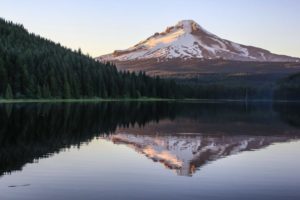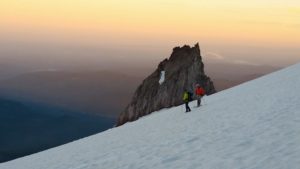
Mt. Hood with lake view. Photo by Bill Bens.
Today’s guest post is by my friend and fellow baby boomer Mitch Stevens, founder of Tucson-based Southwest Discoveries, where he leads tours throughout Arizona and adjoining states.
In this post, Mitch ventures out of his comfort zone into the great Northwest to tackle Oregon’s forbidding, snow-covered Mt. Hood. His entourage consisted of a hiking buddy and a drill sergeant-like guide — but it was his ill-fitting boots and unseasonably warm weather that proved problematic in the end.
By Mitch Stevens
It was an eerie sensation to be grinding along in pre-dawn blackness. We had to start our journey at 12:30 am to avoid melting snow and ice-fall near the summit.
Bundled up against the chill, it was hard to believe that Portland, more than 8,000 feet below in the Willamette Valley, would be baking in 100-degree heat on this late June day.
Many thoughts raced through my mind during the 45-minute ride. Did I bite off more than I could chew? My hiking buddy, Bill Bens, sitting across from me on the snow-cat, murmured as much.
Bill and I were signed up for the summit program on Mt. Hood, the first time either of us had attempted such a feat. Although we were experienced hikers, and Bill attends many of my Sierra Club outings, climbing a technical peak navigating snow and ice was an entirely different undertaking.
But Mt. Hood had been on our collective radar screens for quite some time, and so, intent on accomplishing the deed, we booked the trip.
Prepping for the Climb
My feet still hurt from the “snow school” course the day before.
Our instructor, Phil, a guide at Timberline Mountain Guides, taught us steep snow-climbing techniques, technical rope work and self-arrest.

Climbing snow-covered Mt. Hood. Photo by Bill Bens.
It was recommended that we rent mountaineering boots, crampons, helmet, harness and ice ax. The boots, made of plastic, proved to be uncomfortable, causing painful blisters — especially because I have a of a life-long condition of bunions.
Phil, displaying all the empathy of a Marine drill commander, was unsympathetic.
After the skills course, we had little time to rest before our Sunday morning lift-off time. Bill and I managed less than two hours of sleep each, not a good way to begin a strenuous climb in the dark on an icy and sometimes dangerous mountain. (Well over a hundred people have died climbing Mount Hood.)
Another concern was unseasonably warm conditions, good from the perspective of comfort but bad because the snowpack near the top of the peak must be frozen to minimize the risk of falling rock and ice. The guides the day before mentioned that we might not be able to summit the mountain for that reason.
The Climb Begins
We got off the snow-cat and began climbing in pitch black conditions. Only the lights from our headlamps illuminated the night.
The climb was steep, relentless, tedious and my feet grew increasingly painful.
Phil asked me, “Did you forget everything you learned at snow school yesterday”? He didn’t like the way I was striking the snow with my aching feet. Assuming I was an experienced mountaineer, he had little patience. An hour later we donned crampons as the snow became firmer.
At the Hogback, approximately 700 feet below the summit, we heard ice and rock careening down from the high peaks, confirming that that the snow-pack was unstable. We took a break there as the guides assessed the situation. They decided to abort the climb.
Rewards, Nonetheless
As compensation, views from the Hogback were richly rewarding.
Mt. Hood’s massive volcanic massif lit up, illuminating a glorious scene. We experienced the Hot Rocks Furnace steam vent belching gases on Crater Rock. It brought home the fact that Mt. Hood, as well as other Cascade peaks, are still active volcanoes.
The mountain cast a gigantic shadow across the valley. Other peaks in the Cascades, such as Mt. Jefferson, appeared in the distance. The scene was mesmerizing.
We still had to descend 4,500-foot feet back to Timberline Lodge, an historic and fascinating old hotel we explored the day before. The return trek was lengthy, although increasing light and warmer conditions buoyed our spirits. The landscape remained incredible.
Even though we weren’t successful in cresting Mt. Hood, the excursion proved worthwhile and meaningful — and we almost made it to the top.
Now I want a rematch with Mt. Hood in 2018, this time with leather mountaineering boots! As fellow climber Bill Bens put it, “Just another crummy day in the Great Northwest!”
The author: Mitch Stevens, founder of Southwest Discoveries, has been leading hiking and backpacking outings throughout the southwest for over ten years. As a Sierra Club hiking leader, writer and photographer, he has promoted the enjoyment and conservation of our remaining wild lands. Now, he continues to embrace his fascination with the desert beauty by creating and leading multigenerational tours throughout the southwest. You can read his original story here.
Dear Readers: My new guidebook, 100 Things to Do in Tucson Before You Die (Reedy Press, August 2017) is now available for purchase. For those outside the Tucson area, where it’s available at Barnes & Noble, Antigone Books and other bookstores, you can go to the book’s sale page at amazon.com and order it. Don’t forget to write a review!
Or, if you’d rather support clarknorton.com than Jeff Bezos, you can order directly from me at paypal.me/clarknorton; price of $19.35 includes sales tax and shipping. Be sure to send me an email at clark@clarknorton.com with your name and shipping address. We also accept major credit cards. Thanks!












Leave a Reply